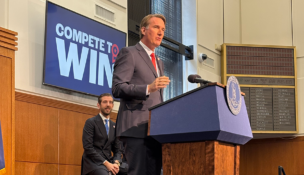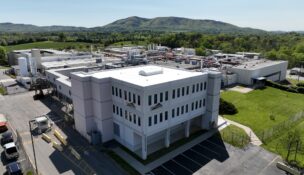New bipartisan, statewide coalition calls for state incentives to boost regional cooperation
New bipartisan, statewide coalition calls for state incentives to boost regional cooperation
Spurred by a sense of urgency due to Virginia’s slow economic growth and recent fall in national business rankings, Virginia government officials, higher education leaders and business executives launched a campaign Tuesday that would use state incentives for regional collaboration to promote economic growth and job creation.
The program, GO Virginia, was announced by the Virginia Business Higher Education Council (VBHEC) and the Council on Virginia’s Future, in a series of events in Norfolk, Richmond, Danville and Blacksburg.
In Richmond, about 80 people turned out for a briefing led by Thomas F. Farrell II, the chairman, president, and CEO of Dominion Resources, and John O. “Dubby” Wynne, the retired president and CEO of Landmark Communications and chairman of the Hampton Roads Community Foundation.
“We are committed to building a broad, bipartisan, statewide coalition that will work to promote private-sector growth in each region and that will campaign for state incentives to encourage regional cooperation,” said Wynne.
He termed the initiative a “game-changing” idea that would provide a new framework for job creation to reverse what he called a “downward spiral.”
In recent years, Virginia’s economy has been hard hit by federal budget cuts to the Department of Defense, whose lucrative contracts have helped boost the state’s economy for years.
“We were shocked to see the drop in our rate of economic growth,” said Wynne. “When you see 48th among the states, we’re not used to that.”
Wynne was referring to the state’s virtually flat real GDP growth in 2014, which placed it 48th among the states, according to the U. S. Bureau of Economic Analysis.
In the years before that, the state’s GDP growth saw a 0.4 percent change in 2013, 0.7 percent in 2012 and 0.6 percent in 2011, with Virginia trailing the federal average all those years.
Virginia, the largest recipient of federal defense dollars, also has dropped in national rankings of best states for business.
In this year’s Chief Executive Best & Worst States for Business, Virginia ranked 14th, a drop of three spots since the 2014 list. The commonwealth came in No. 10 on Site Selection magazine’s annual list of the Top Ten State Business Climates and slipped from No. 1 to No. 4 on Forbes.com’s Best States for Business.
Wynne said the mission of the day was not to release specifics on the new approach but to begin to put in place a long-term structure that would lead to sustained economic success. “We are not talking about new taxes, increasing taxes, mandates or new layers of government,” he said.
In an interview later, Wynne and Farrell said one of the key premises of the model would be that localities with at least one collaborative partner would be able to apply for state-funded incentive grants for new job creation projects.
Asked where the money would come from, Wynne said, “A lot of the money is in there already,” referring to budget allocations for things like workforce development and economic development, that could be repurposed.
According to Mark Hubbard, a spokesman for GO Virginia group, members of the initiative plan to draft legislation for the 2016 General Assembly that would establish the financial resources to incentivize collaboration among regions on job-creation projects.
Gov. Terry McAuliffe, who has made jobs creation his chief priority, was on hand to throw his weight behind the initiative in Norfolk and Richmond. “I’m all in,” he said at the Richmond gathering. “It’s another tool in our tool box,” he said.
Citing Virginia’s past reliance on federal dollars, McAuliffe said “Maybe we didn’t hustle as much as we should have … The economy of the Virginia of old is over. We need to work together to take it to the next level.”
Virginia still has plenty of positives, added the governor, such as a 4.9 percent unemployment rate, a thriving state port and growth in new industries such as cybersecurity and data analytics.
“We need a partnership among business, education and community leaders, local officials and engaged Virginians in each region, all working together to capitalize on the distinctive assets and opportunities in their part of the commonwealth,” he said.
Also supporting the effort were college presidents and high-ranking politicians from both sides of the aisle, including Senate President Pro Tempore Walter Stosch (R-Henrico County), House Majority Leader Kirk Cox (R-Colonial Heights) and Senate Democratic Caucus Leader Donald McEachin (D-Henrico County).
Teresa Sullivan, president of the University of Virginia, said, “We see great potential in this initiative, and we are glad to be a part of it.” She added there are many opportunities for collaboration with businesses on workforce development and research that is coming out research schools such as of U.Va.
GO Virginia identified five ways that state-funded incentives can boost private-sector growth:
Innovation. Innovation and growth in each region can be supported through startup grants for projects that promise substantial economic impact.
Investment. The state can encourage cooperation rather than competition among a region’s localities in recruiting new businesses by returning a portion of the state tax revenues generated by projects to regions where localities share economic development-related costs and revenues.
Improvement. Financial incentives for efficiency-enhancing and cost-saving collaboration among local governments, school divisions and higher education institutions are expected to improve performance and reduce pressures to increase the size and cost of government, freeing up tax dollars for opportunity-focused initiatives.
Invention. Inventions and discoveries leading to commercially viable products and services can be encouraged by the state by providing matching-fund support for labs, equipment, and other research-related needs.
Infrastructure. The state can invest in capital projects of regional or broader significance that will produce strong returns in private-sector growth, diversification and job creation through improved education and job-skills training, research, business site development, communications, and other vital infrastructure.
e
















